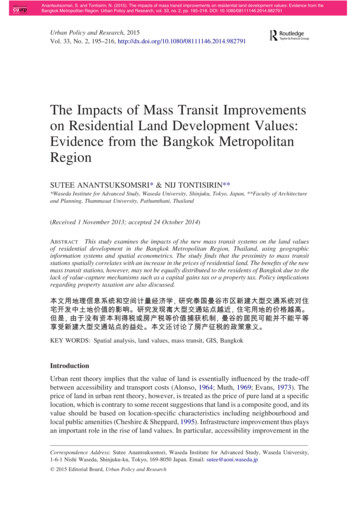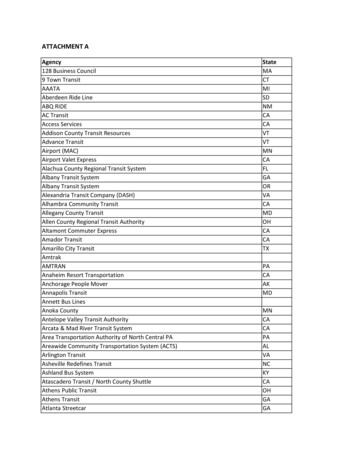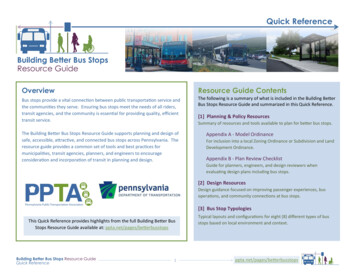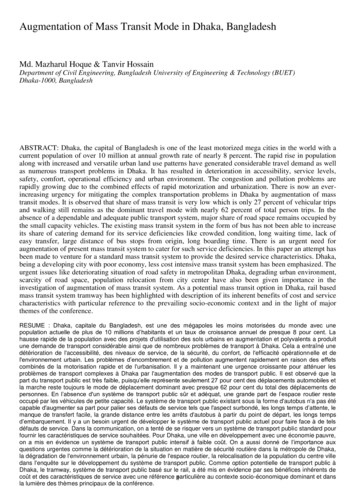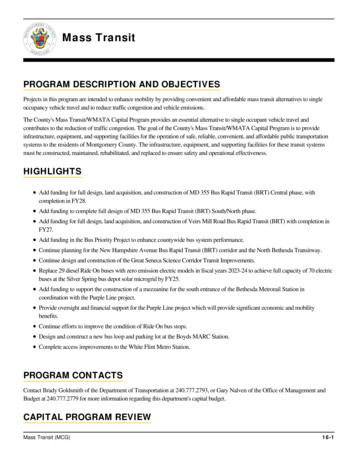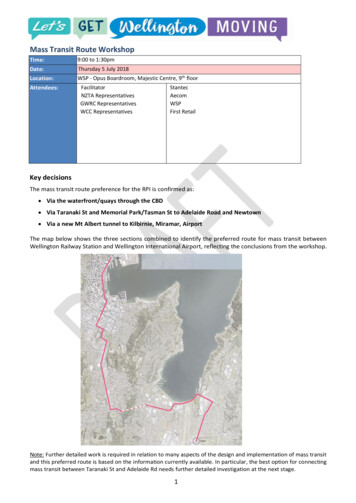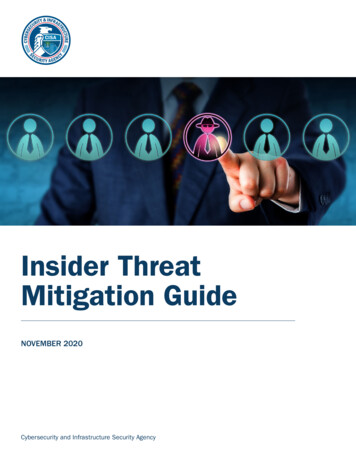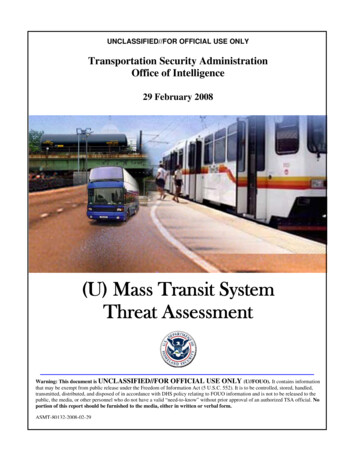
Transcription
UNCLASSIFIED//FOR OFFICIAL USE ONLYTransportation Security AdministrationOffice of Intelligence29 February 2008(U) Mass Transit SystemThreat AssessmentWarning: This document is UNCLASSIFIED//FOR OFFICIAL USE ONLY (U//FOUO). It contains informationthat may be exempt from public release under the Freedom of Information Act (5 U.S.C. 552). It is to be controlled, stored, handled,transmitted, distributed, and disposed of in accordance with DHS policy relating to FOUO information and is not to be released to thepublic, the media, or other personnel who do not have a valid “need-to-know” without prior approval of an authorized TSA official. Noportion of this report should be furnished to the media, either in written or verbal form.ASMT-80132-2008-02-29
UNCLASSIFIED//FOR OFFICIAL USE ONLY1(U) Scope(U) This assessment identifies threats to the United States mass transit system in 20072008, which includes passenger rail, buses, and facilities supporting transit systems.(U) Mass transit includes urban passenger train service (commuter rail), heavy rail(metro, subway, rapid transit, and rapid rail), light rail (street cars and trams), transitbuses, and the interconnected facilities and vehicles feeding the transit system. Accordingto the American Public Transportation Association (APTA), there are about 6,500 publictransportation providers in the United States and Canada.UNCLASSIFIED//FOR OFFICIAL USE ONLYTSA-OI Assessment – 28 Feb 08
UNCLASSIFIED//FOR OFFICIAL USE ONLY2(U) Executive Summary(U//FOUO) At this time, there is no credible intelligence regarding specific plans byany extremist groups or individuals to perpetrate an act of terrorism against the U.S.mass transit system. Extremists, however, remain intent on targeting the U.S. homeland.The volume of previous attacks and recent plotting against mass transit systems overseasdemonstrates continued strong terrorist interest in targeting this sector.(U//FOUO) Previous rail attacks in Madrid (March 2004), London (July 2005), andMumbai (July 2006) could inspire terrorists to conduct similar attacks in the UnitedStates.(U) Key Findings (U//FOUO) The U.S. mass transit and passenger rail systems are vulnerable toterrorist attacks because they are accessible to large numbers of the public and arenotoriously difficult to secure. (U//FOUO) Al-Qa’ida and affiliated extremists pose the greatest threat to theU.S. mass transit and passenger rail system. The threat to heavy and commuterrail in the Homeland is greater than the threat to buses and light rail. Attacks onbuses overseas tend to be small-scale and are carried out mainly by smallerseparatist groups within their own countries. (U//FOUO) Multiple improvised explosive devices (IEDs) and improvisedincendiary devices (IIDs) are the most common means of attacking mass transittargets. Although homemade explosives are more likely to be used, chemical andbiological attacks are also possible agents for terrorism. (U//FOUO) Based on assessments of previous al-Qa’ida and al-Qa’ida-inspiredattacks, future attack plotting against mass transit would likely involve smallgroups of operatives exploding multiple IEDs on rail during rush hour in a majorU.S. city. (U//FOUO) While there have been a number of reported suspicious incidentsconnected to mass transit, there is no evidence to date linking them to terrorism.Suspicious activity, however, can help law enforcement and security officialsidentify unusual behavior, trends, patterns, and possible criminal acts.UNCLASSIFIED//FOR OFFICIAL USE ONLYTSA-OI Assessment – 28 Feb 08
UNCLASSIFIED//FOR OFFICIAL USE ONLY3(U) TSA-OI Modal Assessment: Threats to Mass Transit(U) Threat Overview(U//FOUO) Previous attacks and current reporting indicate that al-Qa’ida and affiliatedterrorist groups remain the greatest threat to the U.S. mass transit system. Mass transitoperates on an advertised schedule and has less physical security than aviation or otherhard-target infrastructure, making it easier for terrorists to both plan and carry out attacks.TSA-OI assesses that the threat to heavy and commuter rail in the Homeland is higherthan the threat to buses and light rail. Attacks on buses overseas tend to be small-scaleand are carried out mainly by smaller separatist groups within their own countries.(U//FOUO) Multiple, simultaneous attacks against rail could cause significant economicdisruption and psychological impact. Al-Qa’ida and affiliated groups have attacked heavyand passenger rail systems overseas with a variety of improvised explosive devices(IEDs) and improvised incendiary devices (IIDs). These devices are especially effectiveagainst subway and passenger rail targets because stations and trains are highly accessibleand concentrate large numbers of people in confined spaces. The closed nature of trains,stations, and subway tunnels enhances the blast effect of explosives.(U//FOUO) Following the March 2004 bombing of commuter trains in Madrid,extremists expressed a strong interest in attacking passenger trains in the United States.Terrorists were specifically interested in striking an above-ground passenger traintraveling between two major cities, and considered New York City and Washington, D.C.as possible targets.(U) Most Likely Actors(U) Transnational Organizations(U//FOUO) The Intelligence Community (IC) assesses that the United States will face apersistent and evolving terrorist threat over the next three years. Al-Qa’ida, its affiliatedgroups, and its sympathizers pose the greatest threat to the U.S. mass transit system.According to the 2007 National Intelligence Estimate, al-Qa’ida will continue to enhanceits capabilities to attack the Homeland. Although the group sustained losses from 20012004, it regained strength and has recouped much of its core operational capabilities inPakistan. It is likely to continue to focus on prominent infrastructure targets, includingtransportation. 1,2(U//FOUO) Lebanese Hizballah, which has supporters inside the United States, is lesslikely to attack U.S. domestic interests unless it perceives the United States has become adirect threat to its leadership, its armed capabilities, or to Iran.UNCLASSIFIED//FOR OFFICIAL USE ONLYTSA-OI Assessment – 28 Feb 08
UNCLASSIFIED//FOR OFFICIAL USE ONLY4(U) Industry Insiders(U//FOUO) The insider poses a significant threat to transportation security. Intelligenceindicates the desire of terrorist groups such as al-Qa’ida to use individuals with insiderknowledge of transportation sectors to help facilitate an attack against the United States. (U) Asmin Amin Tariq, a security guard at Heathrow International Airport(LHR), was one of 24 people arrested in connection with the plan to blow upaircraft in the 2006 UK-U.S. transatlantic plot. Tariq helped Islamic extremistspose as airport employees so they could conduct surveillance of securityprocedures at Heathrow. Tariq allegedly provided information about airportsecurity procedures to the would-be bombers. 3 (U) Turkish citizen Adem Yilmaz, reportedly a member of the Islamic JihadUnion cell targeting Germany, was arrested in September 2007. Yilmaz wasemployed in the security division of rail operator Deutsche Bahn from 1997 until2002. During that time he worked in the railway station of Frankfurt airport. Theairport was one of several targets his cell that allegedly considered. 4(U) Domestic Extremism(U//FOUO) Although TSA-OI assesses that international terrorist groups pose thegreatest threat to U.S. mass transit, it is possible that domestic terrorists could also carryout an attack against this sector. Domestic groups and individuals include, but are notlimited to, right-wing militia, animal and environmental activists, disgruntled employees,and lone individuals. There have been numerous examples of domestic terrorism by loneindividuals (lone wolves), such as the 1995 bombing of the Murrah Federal Building inOklahoma City and the 1996 Centennial Olympic Park bombing.(U) Significant Transnational Mass Transit Attacks(U//FOUO) Although extremists have yet to mount an attack against U.S. mass transit, aseries of significant attacks overseas highlights continuing terrorist interest in attackingthese systems. The examples below summarize major terrorist plots:(U) Spain, January 2008: Spanish authorities arrested 14 suspected terrorists inBarcelona who were allegedly connected to a plot to conduct terrorist attacks in Spain,Portugal, Germany, and the United Kingdom. According to open source reporting, thetarget of the attacks was the Barcelona metro. Two pairs of suicide bombers wereallegedly to attack in separate metro stations. The bombs were supposed to be hidden inbackpacks or bags that other cell members would detonate by remote control. 5UNCLASSIFIED//FOR OFFICIAL USE ONLYTSA-OI Assessment – 28 Feb 08
UNCLASSIFIED//FOR OFFICIAL USE ONLY5(U) India, February 2007: Kashmiri extremistsplaced six suitcase IIDs in three cars of the“Friendship Express” passenger train traveling toPakistan from India. Four of the six IIDs ignitedand caused fires in two passenger cars, killing 68and injuring 13. 6(U) India, July 2006: Seven bombs exploded overa span of 15 minutes on the Mumbai SuburbanRailway system, killing 187 and injuring morethan 700. The railway system is one of the busiest in the world, transporting more thansix million commuters per day. The city of Mumbai is a major financial hub and home tothe Indian film industry. 7(U)(U) United Kingdom, July 2005: Four(U)suicide bombers attacked the Londonunderground subway systems and adouble-decker bus during morning rushhour on 7 July. A total of 52 personswere killed and more than 700 injured.Three suicide bombers exploded IEDswithin a few minutes of each other onthe London underground transit system,and less than an hour later, one bomberexploded an IED on a double-deckerbus. 8 Two weeks later, on 21 July,during the noon hour, four young Islamic extremists in London attempted to conductbombings similar to the 7 July attacks using backpacks containing IEDs made fromperoxide-based explosives. The bombings failed when only the detonator capsthemselves exploded. This may have been due to the low quality of the hydrogenperoxide used. The failed attempts occurred on subway trains at three different stationsand on a double-decker bus in East London. 9(U) Spain, March 2004: Near-simultaneous explosions on four Madrid commuter trainsduring the morning rush hour killed 191 passengers and injured more than 1,800. Ten of13 “bag bomb” IEDs exploded on the four trains—all within three minutes. Groupslinked to al-Qa’ida claimed responsibility for the attack. Some speculate the attacks weretimed deliberately to sway public opinion during the elections. The Popular Party, whohad previously enjoyed a comfortable advantage in the polls, ultimately lost the electionsto the Socialist Party on 14 March, and Spain withdrew its 1,300 troops from Iraq. 10(U) Russia, December 2003: An explosion aboard a commuter train near Yessentuki,northwest of Chechnya, killed 41 people and injured more than 150. Russian officialsblamed a Chechen suicide bomber for the attack. The Chechen resistance has beenresponsible for several train attacks, including a 2003 explosion that killed 46 peopleUNCLASSIFIED//FOR OFFICIAL USE ONLYTSA-OI Assessment – 28 Feb 08
UNCLASSIFIED//FOR OFFICIAL USE ONLY6aboard a commuter train. The Chechen resistance also attacked the Moscow subway threetimes between 1996 and 2004. The 2004 explosion killed 39 and injured 110. 11(U) Capabilities and Tactics(U) Improvised Explosive Devices(U//FOUO) IEDs were used in the majority of recent events against mass transit systemsand will likely remain the most common method of attack for the foreseeable future.IEDs can be constructed from common materials, can be contained in inconspicuous bagsor packages, and can be placed without attracting attention. Suicide operatives carryingIEDs could easily come aboard undetected, especially at a busy time of day whenridership is high.(U//FOUO) According to an October 2007 Joint FBI-DHS report, terrorist interest inperoxide-based explosives is growing. Terrorists in the 7 July 2005 London bombingsand the subsequent attempted bombings on 21 July 2005 used peroxide-based explosives,which included triacetonetriperoixde (TATP) and hexamethylenetriperoxidediamine(HMTD). The members of the Germany-based Islamic Jihad Union cell were in theprocess of purchasing large quantities of high-concentrate hydrogen peroxide when theywere arrested in October 2007. Hydrogen peroxide is commercially available and easy topurchase, making it ideal for use in homemade explosives. 12,13(U) Improvised Incendiary Devices(U//FOUO) IIDs are designed to cause fires or secondary explosions. Terrorists areaware that attacks with incendiary devices in subway systems cause passengers caught innarrow confines with smoke and fire to panic, causing additional injuries and obstructingrescue attempts. Such an attack would also draw in first responders, who could be thetargets of a second-phase attack.(U) Standoff Weapons and Small Arms(U//FOUO) Rocket-propelled grenades, light anti-tank weapons, and small arms could beused to attack mass transit. An example is the 1993 incident in which a lone gunmanopened fire with a 9mm pistol in a crowded Long Island Railroad commuter railcar.(U) Chemical Dispersion(U//FOUO) Terrorists continue to have an interest in developing chemical and biologicaldispersion devices. Many of the necessary materials are relatively easy to acquire, andsome delivery systems can be simple to build. The 1995 chemical attack on the Tokyosubway system was accomplished simply by piercing, with the tip of an umbrella, plasticbags containing sarin, which had been left on subway car floors.UNCLASSIFIED//FOR OFFICIAL USE ONLYTSA-OI Assessment – 28 Feb 08
UNCLASSIFIED//FOR OFFICIAL USE ONLY7(U) Biological Contamination(U) Al-Qa’ida is reportedly interestedin producing compact chemicaldispersal devices. The groupdeveloped a small device called amubtakar for disseminating cyanogenchloride and hydrogen cyanide. Thedevice is considered efficient inenclosed spaces and could beeffective if used in subway cars andunderground rail stations. 14,15(U)(U) Mubtakar (Arabic for “invention”)representation found on Internet(U) Sabotage(U//FOUO) Technologically-capable terrorists could sabotage the Supervisory Controland Data Acquisition (SCADA) systems used for controlling and monitoring mass transitsystems. Although there is no evidence of a specific terrorist threat to mass transitSCADA systems, intelligence reporting indicates al-Qa’ida and affiliated groups have asustained interest in launching operations against computer networks. 16(U) Suspicious Incidents andActivity(U//FOUO) There is no evidence to datelinking suspicious mass transit incidentsto terrorism; however, suspiciousactivity enables law enforcement andsecurity officials to identify unusualbehavior, trends, patterns, and possiblecriminal acts. There were 171 suspiciousmass transit incidents reported to TSA-OIduring 2007. Twenty-nine involvedAmtrak trains, 45 were related to heavyrail, and 97 involved intercity buses.(U//FOUO) A review of all-sourcereporting revealed that approximately123 actual or possible threats to the U.S.(U//FOUO) Rail Fans(U//FOUO) Train spotters (UK) and rail fans(U.S.) are avid fans and hobbyists of railroadsand the railroad industry. There are tens ofthousands of rail fans worldwide, collectingphotographs and documents about trains,engines, rail stations, bridges, and rail yards,which they often disseminate on the Internet.There is no reporting, however, indicating alQa’ida or any other threat group is aware of orutilizing rail fan resources. Rail fan websitesmay contain sensitive information, such asrailway office locations, radio operatingfrequencies, schedules, and pictures ofrailroad operations. In addition, rail fans in theUnited States have tracked nuclear wasteshipments via rail here and posted thisinformation to Internet websites.(U) Classified document: Defense Intelligence Assessment,September 2007UNCLASSIFIED//FOR OFFICIAL USE ONLYTSA-OI Assessment – 28 Feb 08
UNCLASSIFIED//FOR OFFICIAL USE ONLY8passenger rail system were reported since January 2004. None of these threats orincidents preceded an actual attack.(U//FOUO) Suspicious incidents involving mass transit systems encompass a widevariety of activities—from individuals who may appear to be acting suspiciously orasking suspicious questions to incidents involving suspicious packages. Possiblesurveillance includes photographing and videotaping trains and/or train stations. Peopleinvolved in these activities are often rail fans (see pg. x) or tourists taking photographs orvideo of trains or train stations. On other occasions, criminal activity not connected toterrorism is taking place. There are also instances when railroad employees makemistakes that cause equipment malfunctions or failures, making it appear as thoughsabotage has occurred.(U) Predictive Analysis of Possible Future Attacks(U//FOUO) Based on analysis of available data on previous al-Qa’ida/al-Qa’ida-inspiredterrorist attacks on mass transit overseas, TSA-OI assesses that a terrorist attack onU.S. mass transit systems would most likely involve: What: Terrorists would target mass transit rail systems with multiple IEDs or IIDs. Who: The cell would be comprised of small groups of males between the ages of 18and 33. They would likely be either al-Qa’ida members or inspired by al-Qa’ida.Although the cell members may have attended training camp in Pakistan, they mayhave used false documents for travel to make it more difficult to track their movements. When: The attack would occur during the rush hour. Where: The northeast corridor of the United States is likely to be a target because itcontains a significant amount of rail infrastructure relative to the rest of the UnitedStates and has a higher concentration of U.S. cities that might be considered symbolictargets, like New York City and Washington, D.C. Why: Attacking Americans on their home soil has the greatest psychological impact.Groups would likely consider an attack on New York City because it representsmaterial success, or Washington, D.C., because it is the seat of the U.S. government.New York also has the most extensive transit system in the country, increasing itsodds of being targeted from a purely statistical standpoint. One-in-three users of masstransit in the United States and two-thirds of the nation’s rail riders live in New YorkCity.(U) Conclusion(U//FOUO) Law enforcement agencies continue to investigate suspicious activities andthreats related to the mass transit system. Suspicious activity may be indicative of preoperational reconnaissance, but the increase in reported incidents could also be the resultof an elevated public awareness and more stringent security procedures.(U//FOUO) TSA-OI has no credible information regarding any specific terrorist plot toattack U.S. mass transit systems; however, previous overseas attacks against mass transitUNCLASSIFIED//FOR OFFICIAL USE ONLYTSA-OI Assessment – 28 Feb 08
UNCLASSIFIED//FOR OFFICIAL USE ONLY9systems demonstrate the intent and capability of al-Qa’ida, its affiliated groups, and itssympathizers to do so.1(U) National Intelligence Estimate, “(U) The Terrorist Threat to the U.S. Homeland,” July 2007, (U)(U) Director of National Intelligence J. Michael McConnell statement: “(U) Annual Threat Assessment ofthe Director of National Intelligence for the Senate Select Committee on Intelligence,” 5 February 2008,(U)3(U) Open Source Center, “(U) India: Sources Say Jet Airways Security Staffer Among 24 Held for UKTerror Plot,” 12 August 2006, (U)4(U) Spiegel Online, “Terror Suspect Worked at Frankfurt Airport,” 17 September 2007, (U)5www.cnn.com, “Extremists Plotted Attacks Across Europe,” 28 January 2008. (U)6www.news.bbc.co.uk, “Dozens Dead in India Train Blasts,” 19 February 20077www.news.bbc.co.uk, “Scores Dead in Mumbai Train Bombs,” July 20068www.news.bbc.co.uk, “London Attacks,” August 20079www.news.bbc.co.uk, “London Attacks,” August 200710www.news.bbc.co.uk, “Madrid Train Attacks,” February 200711www.washingtonpost.com, 4 February 200712(U//FOUO) FBI-DHS Intelligence Bulletin No.274, “(U//FOUO) Peroxide-Based Explosives: TerroristInterest Growing,” 10 October 2007, (U//FOUO)13(U) Hosenball, Mark and Michael Isikoff, Newsweek, “(U) Suspects Who Got Away,” 10 October 2007,(U)14(U) Salama, Sammy, and David Wheeler, CNS, “(U) From the Horse’s Mouth: Unraveling Al-Qa’ida’sTarget Selection Calculus,” 17 April 2007, (U)15(U) Suskind, Ron, Time, “(U) The Untold Story of Al-Qaeda’s Plot to Attack the Subway,” 19 June2006, (U)16(U) Classified document: DHS Special Assessment, “(U//FOUO) Transnational Groups Ability toCompromise Supervisory Control and Data Acquisition (SCADA) Systems,” 12 December 20052UNCLASSIFIED//FOR OFFICIAL USE ONLYTSA-OI Assessment – 28 Feb 08
(U) AppendixMass Transit Overview(U) Americans take more than 9.6 billion trips annually and 32 million trips per averageweekday on mass transit. Mass transit, or public transportation, incorporates systems that carryvolumes of people over short distances. Mass transit includes urban passenger train service(commuter rail), heavy rail (metro, subway, rapid transit, or rapid rail), light rail (street cars andtrams), transit buses, and the interconnected facilities and vehicles feeding the transit system.The American Public Transportation Association, a U.S. industry group, identifies about 6,500public transportation providers in the United States and Canada.(U) Passenger Rail – The U.S. passenger rail system operates on an open interstate system andon the same tracks as freight rail companies. Passenger rail systems include Amtrak, VirginiaRailway Express, Maryland Rail Commuter, the Long Island Railroad, the Southern CaliforniaRegional Rail Authority, and the Alaska Railroad. Amtrak operates more than 22,000 miles oftrack and serves approximately 24 million people annually at more than 500 station stops. Thevast majority of the 22,000 miles on which Amtrak operates are owned by freight railroads.Amtrak owns approximately 750 miles of railroad, primarily from Boston to Washington, D.C.(U) Heavy Rail/Rapid Transit – Sometimes referred to as subway, underground, elevated, rapidrail, or metro, heavy rail is characterized by high capacity trains operating with high frequency inexclusive rights-of-way. Throughout the United States, there are 14 subway systems consistingof 2,209 track miles, 1,023 stations, and 10,754 subways cars providing 2.7 billion passengerstrips annually. Approximately one-half of these subway stations are located underground. NewYork City hosts the largest and busiest subway system in the country, with more than 6,000scheduled trains carrying more than 3 million passengers per day, for a ridership of 1,850 billionin 2006.(U) Light Rail – Sometimes called streetcar, tramway, or trolley, lightweight passenger railoperates in single vehicles on fixed rails in rights-of-way along roads that may or may not beseparated from vehicular traffic. Light rail transit service is frequent, but with stops spacedfarther apart than for local bus service. The United States has 27 light rail systems consisting of1,147 track miles, 614 stations, and 1,482 vehicles providing 337 million passenger tripsannually.(U) Transit Bus – The vast majority of scheduled fixed route transit service operates in bus andtrolleybus modes on streets and highways using rubber tired vehicles. In all but approximately 50metropolitan areas and small cities, bus service is the only fixed-route transit service available.Throughout the United States, there are 1,982 bus and 4 trolleybus systems, providing nearly 5.7billion bus and over 108.5 million trolleybus passenger trips annually.Source: America Public Transportation Association Public Transportation Fact Book 2005.
terrorist groups remain the greatest threat to the U.S. mass transit system. Mass transit operates on an advertised schedule and has less physical security than aviation or other hard-target infrastructure, making it easier for terrorists to both plan and carry out attacks.
